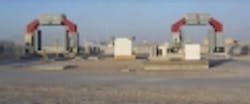Explosive detection technology from AS&E installed at military air base in Afghanistan
KANDAHAR AIR BASE, Afghanistan, 9 Sept. 2010. Officials the Consultation, Command, and Control Agency of the North Atlantic Treaty Organization (NATO C3A) in Brussels, Belgium, needed equipment for explosive detection, as well as to screen for weapons and radioactive materials at the entrance to Kandahar Air Base in Afghanistan. They found their solution from American Science and Engineering Inc. (AS&E) in Billerica, Mass.
NATO C3A has installed and operates the relocatable Z Portal multi-view cargo and vehicle screening system from AS&E, which is designed to scan cars, vans, trucks, and their cargo for concealed threats and contraband before entering Kandahar Air Base in Southern Afghanistan. The advanced counter-improvised-explosive devices (C-IED) systems screen vehicles and people crossing one of the busiest entry control points in Afghanistan. NATO C3A awarded AS&E a $6.2 million contract in May 2008 to deliver Z Portal x-ray screening systems at strategic security checkpoints.
The facility employs state of the art technology that includes vehicle scanners for vehicle borne IED, weapons, and radioactive material detection; pedestrian screening sensors for potential suicide bomber and radioactive material detection; and arch metal detector for additional pedestrian screening. The Z Portal from AS&E is among the screening devices at the entry point in Afghanistan.
Z Portal is a relocatable screening system is available in two sizes -- one for large trucks, buses, and cargo vehicles; and a smaller size for passenger vehicles. Z Portal can be configured as many as three Z Backscatter imaging modules to enable a left, right, and top view of the vehicle under examination. The Z Portal uses AS&E's Z Backscatter technology, which produces photo-like images of the contents of a container or vehicle, highlighting organic materials, such as explosives, illegal drugs, agricultural products, currency, and other contraband.
The NATO C3A-delivered system does not compromise the need for rapid and seamless logistics that Kandahar relies on, NATO officials say. The vehicle screening sensors will operate in parallel and will screen hundreds of vehicles daily.
For more information contact the NATO C3A organization online at www.nc3a.nato.int, or AS&E at www.as-e.com.
